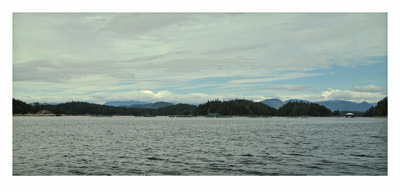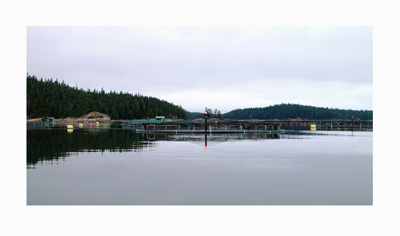Broughton Archipelago I:
Introduction
With the environmental damage being perpetrated concealed even at a close range, the beauty of this “wilderness landscape” evokes the terror of the sublime.
Zeigler’s four-part Broughton Archipelago series seeks to problematize conventional representations of land and “landscape,” and bring to mind the political consequences of this romanticized misrepresentation of non-urban environments. Dwarfed by the mountains and vast sea, the Broughton Archipelago appears, at first glance, to be a “wilderness landscape” – the region’s high concentration of fish farms remaining invisible to tourists and provincial/federal policy makers, alike.
Inhabited by First Nations Peoples for thousands of years and logged and fished extensively by settlers throughout the twentieth century, in the twenty-first century, the marine ecosystems of the Broughton Archipelago are under threat. Open-net cage Atlantic fish farming, the presence of sea-lice, and more recent reports of ISA virus, piscine reovirus, and Kudao parasites in BC Atlantic farmed salmon all are of grave concern in regard to the region’s marine ecosystem at large.
 5. Fish Farm, Indian Channel, Broughton Archipelago, BC, 54.6 x
114.3 (21.5 x 45”), digital archival pigment print, 2005-08.
5. Fish Farm, Indian Channel, Broughton Archipelago, BC, 54.6 x
114.3 (21.5 x 45”), digital archival pigment print, 2005-08.
 3. Fish Farm Net Pens, Indian Channel, Broughton Archipelago, BC,
53.3 x 83.8 cm (21 x 23”), archival digital pigment print, 2005-07.
3. Fish Farm Net Pens, Indian Channel, Broughton Archipelago, BC,
53.3 x 83.8 cm (21 x 23”), archival digital pigment print, 2005-07.